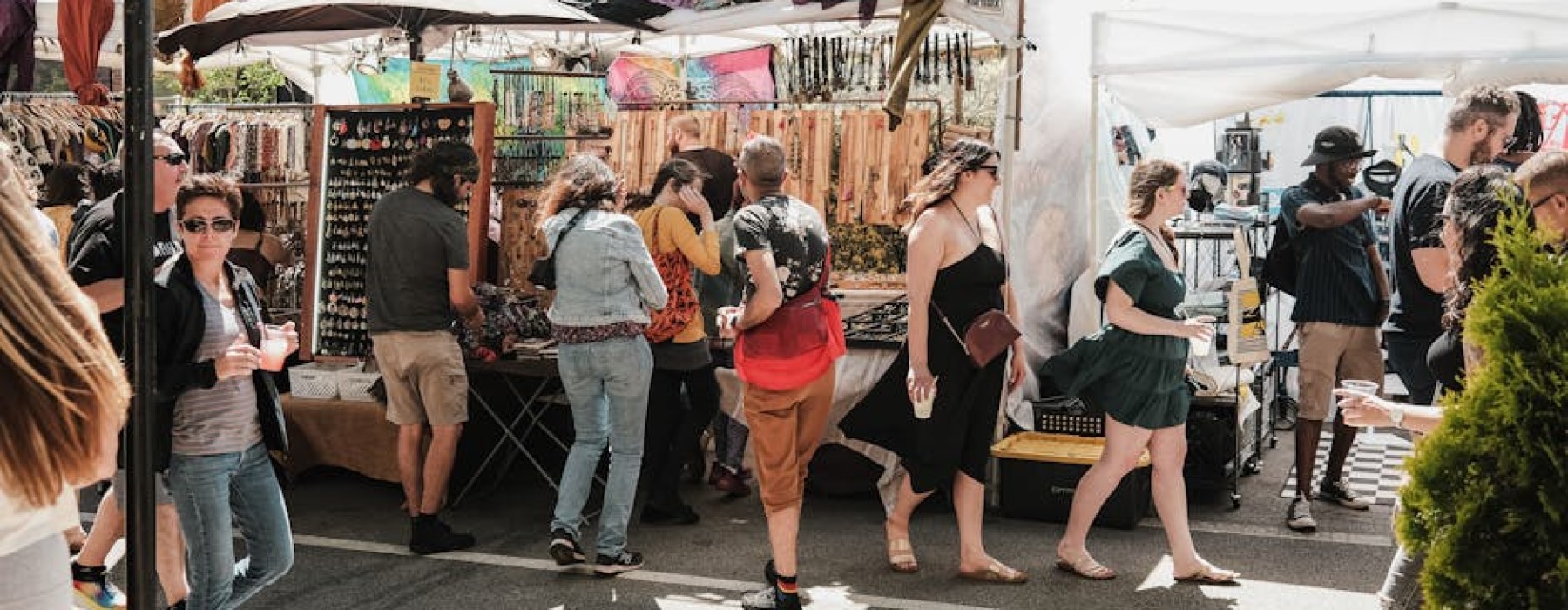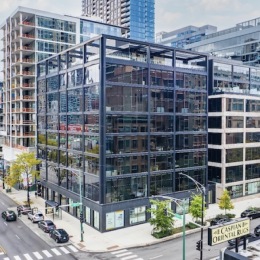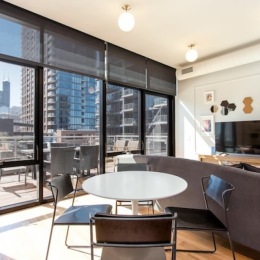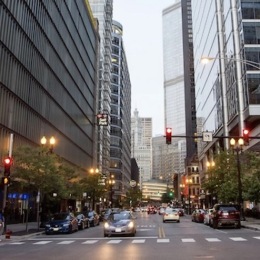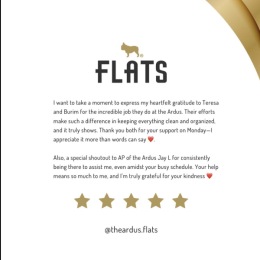The Business Boom of Fulton Market: Chicago's Innovation District
Chicago Fulton Market is a dynamic district on the city's Near West Side that has transformed from a historic meatpacking hub into one of the hottest commercial and cultural destinations in the Midwest.
For those exploring commercial opportunities in Fulton Market, here's what you need to know:
- Location: Situated on Chicago's Near West Side, spanning 74 acres of landmarked district
- Transit: Served by CTA Green and Pink Lines at Morgan Station, plus bus routes 8 and 56
- Commercial Growth: Office space expanded from 995,898 sq ft in 2017 to 4.3+ million sq ft in 2020
- Key Industries: Food service, tech, hospitality, creative agencies, and corporate headquarters
- Major Companies: Google, McDonald's, Kimberly Clark, Dyson, Herman Miller, and Mondelez
Once lined with meat processors and food distributors, Fulton Market has experienced a remarkable evolution over the past decade. The district now hosts more than 120 restaurants and retailers, up from just 56 before 2017. This growth reflects the area's rapid transition from industrial center to innovation hub.
The landmarked portion of Fulton Market (officially the Fulton-Randolph Market District) received its Chicago Landmark designation in 2015, preserving its distinctive architectural character while accommodating modern development. This balance of historic charm and contemporary energy makes it uniquely attractive to businesses seeking an authentic urban setting.
Hotel capacity has skyrocketed from a mere 40 keys pre-2017 to 727 by 2020, with projections reaching 2,661 in the near future. Similarly, residential units have grown from 450 to 894 in the same period, with 3,725 units expected at full build-out. These numbers tell the story of a neighborhood in high demand, where historic warehouses now house some of the city's most coveted commercial real estate.
Where Is Chicago Fulton Market District?
Just a mile west of Chicago's busy Loop lies the vibrant Chicago Fulton Market district, a neighborhood that perfectly blends historic charm with modern energy. Nestled in the Near West Side, this dynamic area centers around the busy east-west corridor formed by Fulton Market Street and Randolph Street.
The district's boundaries create a distinct pocket of urban excitement, stretching from Halsted Street on the east to Ogden Avenue on the west, while spanning from Hubbard Street on the north down to Washington Boulevard on the south. At its historic core sits the officially designated Fulton-Randolph Market District – a 74-acre area that most Chicagoans simply call Fulton Market.

Pinpointed at coordinates 41°53′08″N 87°39′04″W, Fulton Market's strategic location offers the perfect balance – close enough to downtown for convenience, yet far enough to maintain its own unique character and vibe. This prime positioning has played no small role in the neighborhood's remarkable commercial success story.
Coordinates & Transit Connections to chicago fulton market
Getting to Fulton Market couldn't be easier, with transportation options that make this foodie paradise and tech hub accessible from virtually anywhere in Chicago:
The Morgan Station serves as the neighborhood's transit heartbeat, where both Green and Pink Line trains deliver visitors and commuters directly into the district. This station, which opened in 2012, has been a game-changer for the area's development and accessibility.
Fulton Market is also well-served by CTA bus routes 8 and 56, connecting the neighborhood to Chicago's extensive public transit network. For those coming from the suburbs, Ogilvie Transportation Center is just a pleasant 10-15 minute walk away, offering convenient Metra rail connections.
Cyclists love the area's dedicated bike lanes and numerous Divvy bike-sharing stations scattered throughout the district. And if you're driving, major arteries like Halsted, Lake, and Randolph Streets provide easy access, with several parking garages available for those who need them. The nearby I-90/I-290 expressways connect Fulton Market to the broader Chicagoland area.
With an impressive WalkScore of 94, the neighborhood ranks as one of Chicago's most pedestrian-friendly areas. This walkability has become one of Fulton Market's biggest selling points – visitors and locals alike appreciate being able to explore the district's restaurants, shops, and galleries on foot.
For travelers, the neighborhood offers straightforward connections from both major airports – the CTA Blue Line from O'Hare and Orange Line from Midway both connect to the Green and Pink Lines, making Fulton Market an accessible destination for visitors from near and far.
From Stockyards to Start-Ups: The History & Landmark Status
The story of Chicago Fulton Market is a remarkable tale of urban reinvention – from gritty industrial beginnings to today's buzzing innovation district.
Meatpacking Roots and Market Origins
What began as Haymarket Square in the 18th century, primarily serving Chicago's hay traders, evolved into something much more significant. By the 1850s, with the construction of the original market hall, the area established its identity as a vital food distribution center.
During the Civil War era, Chicago Fulton Market transformed into a busy meatpacking powerhouse. The district's stockyards processed millions of cattle and hogs annually by 1890, cementing Chicago's reputation as "hog butcher for the world" – a phrase immortalized by poet Carl Sandburg.
The area's history wasn't all commerce and prosperity, though. The Haymarket affair of 1886 – a labor demonstration that turned tragically violent – brought national attention to the district and became a defining moment in American labor history.
Mid-Century Transition
The Great Depression marked a turning point for Chicago Fulton Market. As refrigerated trucks gained popularity in the 1930s, food distribution shifted away from centralized city warehouses toward more scattered suburban locations. Though the market continued operating as a food hub, its dominance began to fade.
Throughout the middle decades of the 20th century, the district maintained its industrial character but faced gradual decline. Manufacturing and food processing businesses increasingly sought lower operating costs in suburban and rural locations, leaving behind historic buildings and a neighborhood in transition.
Artist-Led Revival and Corporate Arrival
The 1980s brought the first whispers of change as artists finded the potential in the district's vacant warehouses. These creative pioneers transformed empty industrial spaces into studios and lofts, breathing new life into the neighborhood and setting the stage for its next chapter.

A more dramatic shift began in 2008 when corporate interest in the area grew. Nearby Harpo Studios, founded by Oprah Winfrey, signaled the area's potential for upscale development. But the true game-changer came in 2015 when Google established its Chicago headquarters in the former Fulton Market Cold Storage building – triggering a tech boom that continues reshaping the district today.
This change has been well-documented, with Curbed's deep dive providing an excellent chronicle of the neighborhood's rapid evolution over the past decade.
2015 Landmark Designation
Recognizing both the historical significance and increasing development pressure, the City of Chicago designated the Fulton-Randolph Market District as an official Chicago Landmark on July 29, 2015 (effective September 24, 2015).
The district earned its landmark status by meeting three critical criteria:
- Value as city, state, or national heritage – acknowledging its role in Chicago's commercial development
- Exemplary architecture – recognizing the distinctive industrial buildings that define the area
- Distinctive theme as a district – protecting the cohesive character of this historic market area
Why the Fulton-Randolph designation matters
This landmark status has been crucial in balancing preservation with progress. It ensures that while Chicago Fulton Market evolves, it never loses the authentic character that makes it special.
The designation protects distinctive streetscape elements – including those charming historic cobblestones that give certain streets their unique feel. It requires that work affecting exterior facades visible from public areas receives approval from the Commission on Chicago Landmarks.
For building owners, the landmark status offers tangible benefits, including access to federal, state, and local economic incentive programs for historic rehabilitation. The designation also provides greater flexibility through Chicago's Rehabilitation Code when adapting historic structures for modern uses.
This thoughtful approach allows the district to grow while maintaining its soul. New construction and modern additions aren't prohibited – they're simply guided to respect the historic context that makes Chicago Fulton Market so appealing to businesses and visitors seeking an authentic urban experience.
For those looking to live near this dynamic district, The Ardus Apartments offers the perfect blend of historic character and modern convenience, just a short distance from all the action.
Business Meets Buzz: Industries, HQs & Real-Estate Metrics
The change of Chicago Fulton Market into a premier business district tells one of the most exciting stories in American urban development. What was once the domain of meat packers and food distributors has become a magnet for diverse industries—from tech giants to creative agencies—all drawn to its unique blend of historic character and contemporary energy.
Commercial Growth By The Numbers
The numbers behind Fulton Market's evolution are nothing short of remarkable:
| Category | Pre-2017 | 2020 | Future Projection | Growth Rate |
|---|---|---|---|---|
| Office Space (sq ft) | 995,898 | 4,360,895 | 8,100,883 | 337% (2017-2020) |
| Leasing Rate | 96% | 75% | 44% pre-leased | 92% of delivered inventory leased |
| Residential Units | 450 | 894 | 3,725 | 98% (2017-2020) |
| Hotel Keys | 40 | 727 | 2,661 | 1,717% (2017-2020) |
| Restaurants/Retailers | 56 | 120+ | Continuing growth | 114%+ (2017-2020) |
These figures tell a story of explosive growth that few neighborhoods anywhere can match. Office space has more than quadrupled since 2017, yet demand remains strong with 92% of delivered inventory leased. The hotel sector has seen particularly dramatic expansion, growing from just 40 rooms before 2017 to over 700 by 2020, with projections suggesting further massive growth ahead.
Industry Mix and Corporate Presence
Walk through Chicago Fulton Market today and you'll find yourself surrounded by a diverse ecosystem of businesses that would have been unimaginable two decades ago:
Tech anchors the district, with Google's Chicago headquarters leading the way from its home in a converted cold storage facility. The tech giant's presence has created a gravitational pull, attracting numerous startups and established tech companies looking to tap into the same creative energy.
Food service innovation has replaced food production, most symbolically with McDonald's global headquarters relocating to the district in 2018. The move brought approximately 2,000 employees to the area and signaled a new chapter in the neighborhood's food-related identity.

Design and manufacturing companies have found inspiration in the district's industrial past. Brands like Dyson and Herman Miller have established flagship locations that honor the area's heritage while showcasing contemporary innovation.
Consumer goods giants including Kimberly Clark and Mondelez have set up regional offices, drawn by the district's central location and vibrant atmosphere.
Creative agencies fill many of the beautifully renovated loft spaces, with advertising, design, and marketing firms thriving in an environment that seems tailor-made for creative work.
Food distribution businesses, while fewer in number than in decades past, maintain a presence that connects the district to its roots. The Fulton Market Company, operating since 1932, represents this continuing legacy.
Corporate wave reshaping chicago fulton market
The influx of corporate headquarters has transformed Chicago Fulton Market in ways both visible and invisible:
Tech talent concentration has created a self-reinforcing ecosystem where companies and skilled professionals are drawn to each other. This clustering effect has turned the district into a hub of innovation and collaboration.
Coworking spaces have flourished, with flexible workspace providers establishing significant footprints to serve growing companies and remote workers seeking community and amenities.
Venture capital firms have moved in to be closer to the startups they fund, creating easier access to capital for entrepreneurs in the district.
Job creation has been substantial, with thousands of new positions established since 2017, changing the area into a major employment center for Chicago.
Amenity growth has followed the workforce, with restaurants, fitness centers, and service businesses multiplying to meet the needs of the district's daytime population.
For businesses considering a move to Chicago Fulton Market, the district offers a rare combination of historic character, modern infrastructure, and a concentration of talent that creates genuine competitive advantages. While commercial real estate commands premium rates, many companies find that the benefits of being part of this dynamic ecosystem—including talent attraction, brand positioning, and collaborative opportunities—more than justify the investment.
Eat, Drink, Stay: Restaurants, Bars & Accommodation
Chicago Fulton Market has transformed from its humble beginnings as a food distribution hub into one of the city's most vibrant culinary playgrounds. This neighborhood now stands as a guide for food lovers, night owls, and travelers seeking authentic Chicago experiences with a contemporary twist.
Restaurant Scene Overview
Randolph Street—affectionately dubbed "Restaurant Row" by locals—forms the southern edge of Chicago Fulton Market and showcases an impressive collection of dining destinations. What once housed meat packers and produce wholesalers now welcomes food enthusiasts from across the globe. The district's restaurant count has more than doubled in recent years, now boasting over 120 eateries that range from casual bites to fine dining experiences.
What makes dining in Chicago Fulton Market special is the neighborhood's commitment to preserving its industrial soul. Former warehouses with exposed brick and timber beams now house some of the city's most innovative kitchens. Many acclaimed chefs have chosen this district to showcase their culinary vision, drawn to both its historical character and forward-thinking energy.
The dining landscape offers something for every palate. You'll find intimate chef's counters serving carefully crafted tasting menus alongside casual spots where you can grab a quick sandwich. Global influences abound, with Mediterranean, Asian, Latin American, and classic American cuisines all well-represented.
For those who can't decide on just one restaurant, Time Out Market Chicago provides a curated food hall experience featuring some of the city's most beloved culinary concepts under one roof. And when the weather cooperates, several venues offer stunning rooftop dining with sweeping views of Chicago's iconic skyline—the perfect backdrop for a memorable meal.
Must-visit dining in chicago fulton market
When exploring the neighborhood's food scene, these standout destinations deserve a spot on your must-visit list:
Aba brings Mediterranean flair to the district with a stunning rooftop patio draped in greenery. Their mezze plates, succulent kebabs, and herb-infused cocktails transport diners to a sun-drenched coastal escape, even in the heart of the Midwest.
La Serre offers a French-inspired retreat with its greenhouse-like atmosphere. The seasonal menu showcases fresh ingredients in dishes that are both comforting and refined.
Boqueria captures the vibrant energy of Barcelona's tapas culture with shareable Spanish small plates and flowing sangria. It's perfect for gathering with friends and sampling a variety of flavors.
Cruz Blanca brings together two beloved indulgences—craft beer and Oaxacan-style tacos—courtesy of Chicago culinary icon Rick Bayless. The house-brewed beers perfectly complement the smoky, spice-forward food menu.
Guinness Open Gate Brewery offers a taste of Ireland with a Chicago twist. As only the second U.S. location of this storied brewery, it serves both the classic stouts you know and experimental brews you won't find anywhere else.
Beyond these highlights, the district offers culinary gems like Momotaro with its sophisticated Japanese cuisine, Swift & Sons for a modern take on the classic Chicago steakhouse, and Fulton Market Kitchen where art and dining merge seamlessly. The Aviary lifts cocktails to culinary art forms, while Rose Mary blends Croatian and Italian influences in one of the neighborhood's most sought-after dining rooms.
Bar and Nightlife Scene
When the sun sets, Chicago Fulton Market truly comes alive. The district's beverage scene rivals its food offerings, with options ranging from sophisticated cocktail lounges to lively brewpubs.
Craft beer enthusiasts will feel right at home exploring the neighborhood's brewery taprooms, where locally-made IPAs, stouts, and experimental brews flow freely. For those who prefer grapes to grain, intimate wine bars like Grapes and Grains offer carefully curated selections from around the world.
Cocktail culture thrives in Chicago Fulton Market, with venues like Lazy Bird and The Aviary elevating mixology to an art form. These establishments treat drinks as sensory experiences, incorporating unexpected ingredients, theatrical presentations, and meticulous attention to detail.
For those seeking more interactive entertainment with their libations, venues like Punch Bowl Social and Emporium blend drinking with activities like bowling, vintage arcade games, and ping pong—perfect for breaking the ice on date nights or group outings.
Top hotels around chicago fulton market
The hospitality landscape in Chicago Fulton Market has undergone a remarkable change. From just 40 hotel rooms before 2017, the district now offers over 700 keys, with projections suggesting that number will grow to more than 2,600 in the coming years.
The Hoxton brings London-inspired cool to Chicago with 182 stylishly appointed rooms. The hotel doubles as a social hub with multiple dining options, including the popular rooftop restaurant Cabra, and versatile coworking spaces.
Nobu Hotel Chicago offers a serene escape with 115 rooms that blend Japanese minimalism with urban sophistication. The property includes the world-renowned Nobu restaurant, making it a destination for travelers and locals alike.
The Emily Hotel captures the creative spirit of the neighborhood with distinctive design touches and the popular rooftop pool club Cabra. The ground-floor restaurant Cira provides guests with exceptional Mediterranean cuisine without leaving the building.
For travelers seeking a more intimate experience, Publishing House B&B occupies a historic former publishing house with just 11 uniquely designed rooms. Each space tells its own story through thoughtful décor and architectural details.
Extended-stay options like Sonder Market Hall and Level Chicago Fulton Market cater to business travelers and temporary relocations with apartment-style accommodations that include full kitchens and residential amenities.
If you're looking to stay near Chicago Fulton Market while enjoying the comforts of home, The Ardus Apartments offers the perfect solution. Located in nearby River North, our modern living spaces provide easy access to all the culinary and cultural experiences the Fulton Market district has to offer, along with unique amenities like our rooftop lounge and on-site coffee shop. After a day of exploring the neighborhood's restaurants and bars, you'll appreciate returning to our thoughtfully designed apartments that blend historical character with contemporary comfort.
See & Do: Art, Culture, Activities & Getting Around
Beyond its impressive dining and business credentials, Chicago Fulton Market pulses with creative energy and entertainment options that make it a playground for culture enthusiasts and fun-seekers alike.
Art and Cultural Scene
The district's industrial bones have created the perfect canvas for artistic expression. Former warehouses with soaring ceilings and abundant natural light now house several contemporary art galleries, giving visitors a chance to experience Chicago's vibrant art scene up close.
As you wander the streets, you'll encounter colorful murals and public art installations that tell the story of the neighborhood's evolution. Many celebrate the area's industrial heritage while others offer bold, modern statements that reflect the district's forward-thinking spirit.
While rising property values have shifted some artist studios to neighboring areas, Fulton Market maintains its creative soul. The unique Fulton Market Kitchen embodies this perfectly – it's not just a restaurant but a living gallery where you can enjoy dinner surrounded by rotating exhibitions and even watch artists create new works during biweekly live painting sessions.
Design enthusiasts shouldn't miss the showrooms of iconic brands like Herman Miller, where architectural significance meets product innovation in beautifully curated spaces.

Markets and Events
True to its name, Fulton Market continues its market heritage, though in forms that would surprise its early merchants. The beloved Randolph Street Market brings treasure hunters together to browse vintage finds, quirky collectibles, and handcrafted goods from local artisans.
Throughout the year, the impressive Morgan Manufacturing venue transforms to host everything from corporate gatherings to cultural celebrations in its industrial-chic space. Food festivals pop up regularly, honoring the district's deep culinary roots, while temporary installations and experiences continually refresh the neighborhood's offerings.
Entertainment and Activities
When you're ready for more active fun, Fulton Market delivers with unexpected entertainment options. Puttery offers a grown-up take on mini-golf with themed courses and craft cocktails – mini-golf for adults who appreciate good design and better drinks.
Nostalgia meets nightlife at Emporium Arcade Bar, where 65 classic arcade games and pinball machines stand ready alongside an impressive selection of craft beers. For a different kind of play, Punch Bowl Social combines bowling lanes, karaoke rooms, and vintage games with a full food and drink menu.
Music lovers should check the schedule at nearby Union Park, just west of the district, which hosts major events including the renowned Pitchfork Music Festival. Meanwhile, Time Out Market goes beyond food with regular cooking demonstrations and cultural events that bring the community together.
Getting there & getting around
With a stellar WalkScore of 94, Fulton Market practically begs to be explored on foot. Most attractions sit within a pleasant 5-10 minute walk of each other, making it easy to wander between galleries, restaurants, and shops.
The Morgan Station on the CTA Green and Pink Lines serves as the district's transit hub, while those coming from western neighborhoods might prefer the Clinton 'L' station. For suburban visitors, Metra's Ogilvie Transportation Center is within walking distance, putting Fulton Market within easy reach of Chicago's outlying communities.
Bright blue Divvy bikes dot the neighborhood, offering a quick and fun way to explore, while designated rideshare zones help manage traffic flow. If you're taking public transit, CTA bus routes 8 and 56 provide direct service to the area.
For those staying at The Ardus Apartments, our River North location puts you just a short walk, quick bike ride, or easy transit trip away from all that Fulton Market has to offer. Our residents love being able to dive into the excitement of this dynamic district while returning to the comfortable elegance of their homes just minutes away.
Looking Ahead: Development Pipeline & Lifestyle Comparison
The change of Chicago Fulton Market continues at an impressive pace, with ambitious plans that promise to further lift this already dynamic district in the coming years.
Future Development Landscape
Walk through Fulton Market today and you'll see construction cranes dotting the skyline—tangible evidence of the district's ongoing evolution. The development pipeline is robust and diverse, reflecting the area's growing appeal to residents, businesses, and visitors alike.
Several mixed-use towers are currently under construction or in the planning stages, set to dramatically increase the district's residential, office, and hotel capacity. These modern high-rises will stand in striking contrast to the historic low-rise warehouses that have long defined the neighborhood's character.
Perhaps most exciting is Fulton Market's emergence as a hub for innovation in the life sciences. Specialized facilities designed for biotech companies and research organizations are being developed, potentially creating an entirely new industry cluster in the district.

Sustainability has become a cornerstone of new development in the area. From LEED-certified buildings to green roofs and energy-efficient systems, developers are increasingly incorporating environmentally conscious features into their projects. This focus on sustainability aligns with Chicago's broader climate goals while creating healthier spaces for workers and residents.
The numbers tell a compelling story about Fulton Market's trajectory:
- Office space is projected to reach 8.1 million square feet (an eightfold increase from 2017)
- Residential units will grow to approximately 3,725 (more than eight times the pre-2017 number)
- Hotel keys will expand to 2,661 (compared to just 40 before 2017)
With this remarkable growth comes both opportunity and challenge. While the development boom creates exciting commercial possibilities and improves local amenities, it also raises important questions about affordability, preservation of the district's unique character, and whether existing infrastructure can accommodate such rapid expansion.
Public space improvements are planned to help address some of these concerns, with improved streetscapes, new plazas, and pedestrian-friendly amenities designed to make the district more livable as its population density increases. Additionally, some new residential developments include affordable housing components as part of Chicago's inclusionary housing requirements, though debates about accessibility and affordability continue.
Lifestyle Comparison with Other Chicago Neighborhoods
If you're considering Fulton Market as a place to live or work, you might wonder how it stacks up against other popular Chicago neighborhoods.
Compared to River North, Fulton Market offers a distinctly different vibe. While both areas buzz with energy, Fulton Market accepts its industrial roots with exposed brick, converted warehouses, and a slightly grittier aesthetic. River North, by contrast, presents a more polished, established luxury feel. At The Ardus Apartments, we've found the perfect balance—our River North location provides established amenities and slightly quieter evenings, while keeping you just minutes from Fulton Market's creative energy.
The Loop might be Chicago's traditional downtown core, but Fulton Market provides a refreshing alternative with its less corporate atmosphere. You'll find more independent businesses, creative workspaces, and character-filled buildings here than in the high-rise canyons of The Loop. The dining scene in Fulton Market also outshines its downtown counterpart, with a density of acclaimed restaurants that's best elsewhere in the city.

While Fulton Market is technically part of the broader West Loop area, it represents the most dynamic and rapidly evolving section, with higher concentrations of dining destinations and creative workspaces. The West Loop beyond Fulton Market offers a slightly more residential feel, though the boundaries between these areas continue to blur as development spreads westward.
For businesses, setting up shop in Fulton Market offers several distinct advantages. The district's reputation and amenities help companies attract and retain top talent, particularly among younger professionals who value urban vibrancy and authentic experiences. Historic buildings retrofitted with modern interiors create memorable client experiences that can differentiate businesses from competitors.
The concentration of corporate headquarters facilitates networking and business development, creating opportunities for chance encounters and collaborations that might not happen in more dispersed locations. Perhaps most valuable is the innovative environment itself—the density of forward-thinking companies and creative energy fosters a culture of innovation that many businesses find invaluable.
At The Ardus Apartments, we've witnessed how our residents value living in proximity to Fulton Market while enjoying the established amenities of River North. Our property's change from a historic warehouse to modern apartments mirrors Fulton Market's own evolution, creating a natural affinity between our residents and this dynamic district just a short walk away.
Frequently Asked Questions about Chicago Fulton Market
What makes Fulton Market different from other Chicago neighborhoods?
Chicago Fulton Market stands out as a neighborhood that beautifully marries its industrial past with an innovative future. While many Chicago neighborhoods have distinct personalities, Fulton Market's change story is particularly compelling.
The district's character is immediately recognizable through its architectural landscape. Historic brick warehouses stand shoulder-to-shoulder with gleaming glass towers. Former meatpacking facilities now house Michelin-starred restaurants. Cold storage buildings have become tech innovation hubs. This visual juxtaposition creates a streetscape unlike anywhere else in Chicago.
Walking down the preserved cobblestone streets, you'll notice the thoughtful preservation of loading docks and industrial facades that tell the story of the neighborhood's working-class origins. Yet step inside these buildings and you'll find some of the most forward-thinking companies and concepts in the city.
Perhaps most distinctive is the palpable energy of a place in motion. While neighborhoods like River North and Lincoln Park have largely settled into their identities, Fulton Market continues to evolve before your eyes, creating excitement and possibilities that attract those who thrive on innovation and change.
How will future zoning impact small businesses?
The balancing act between preservation and progress in Fulton Market plays out most visibly through the district's zoning framework. The 2015 landmark designation combined with the Fulton Market Innovation District plan creates guardrails for development while allowing for growth.
For small business owners, this dynamic creates a mixed landscape. On one hand, provisions aimed at maintaining the district's food-related heritage help prevent complete displacement of long-standing businesses. Some developments are required to include ground-floor commercial spaces, creating opportunities for retail and service businesses to establish a presence.
Property owners who rehabilitate historic buildings can access tax incentives, potentially creating more affordable spaces for small businesses. These preserved spaces often become the most sought-after locations, as they offer the authentic character that draws customers to the district.
The challenge, of course, is affordability. As property values have skyrocketed, rents have followed suit. Small businesses that succeed in today's Fulton Market typically align closely with the district's evolving identity – think artisanal food producers, design-forward retail concepts, and specialized services catering to the tech workforce and growing residential population.
Is Fulton Market easy to reach by public transit from O'Hare and Midway?
Getting to Fulton Market from either of Chicago's airports is refreshingly straightforward, making it accessible for visitors and commuters alike.
From O'Hare International Airport, your journey takes about an hour via public transit. Hop on the CTA Blue Line directly from the airport terminal to the Clark/Lake station downtown. There, transfer to the westbound Green or Pink Line and exit at Morgan station – you'll find yourself in the heart of Fulton Market. The system is well-marked, and trains run frequently throughout the day.
Traveling from Midway? Your trip will be even quicker at approximately 45 minutes. Take the CTA Orange Line from Midway to Clark/Lake, then follow the same transfer to the Green or Pink Line to Morgan station. The liftd platform at Morgan offers a great first glimpse of the neighborhood as you arrive.
For those with luggage or preferring more direct transportation, rideshare services and taxis provide door-to-door service from both airports in about 25-45 minutes, depending on traffic conditions. Many of the district's hotels also offer airport shuttle arrangements for guests.
The convenience of these transit connections has been a significant factor in the district's growth, making it accessible for both daily commuters and occasional visitors exploring Chicago's newest hotspot. For residents of The Ardus Apartments, this connectivity means easy access to both airports when traveling, adding another layer of convenience to urban living.
Conclusion
Chicago Fulton Market embodies the art of urban reinvention at its finest. This remarkable district has managed to honor its industrial roots while boldly stepping into an innovation-focused future. What began as a humble food distribution center has blossomed into a vibrant hub where corporate innovation, culinary excellence, and cultural experiences converge in perfect harmony.
For businesses looking to make their mark, Chicago Fulton Market presents an irresistible blend of old and new. The distinctive character of historic warehouses alongside sleek modern architecture creates an atmosphere that simply can't be replicated elsewhere in the city. With exceptional transit connections and a growing concentration of talent, companies find themselves in an ecosystem designed for success.
The numbers tell a compelling story of momentum that shows no signs of slowing. With millions of square feet of office space, thousands of residential units, and hundreds of hotel rooms in active development, Fulton Market's trajectory points firmly upward. This growth isn't just about buildings—it's about creating a dynamic community where ideas and opportunities flourish.
The district's designation as an Opportunity Zone adds another layer of appeal for certain investments. These financial incentives have helped attract a diverse mix of ventures, from tech startups to culinary innovators, all contributing to the area's vibrant energy.
What truly sets Chicago Fulton Market apart is its perfect live-work-play balance. Employees love the walkable streets lined with top-tier restaurants and cultural venues. Businesses thrive in an atmosphere where creativity flows naturally and networking happens organically over craft cocktails or innovative cuisine. The district pulses with an energy that's both productive and inspiring.
For those drawn to this dynamic neighborhood but seeking a slightly quieter home base, The Ardus Apartments offers the ideal solution. Our River North location puts you just minutes from all the excitement of Fulton Market while providing a comfortable retreat at day's end. Our modern living spaces, thoughtfully transformed from a former warehouse, mirror the same adaptive reuse philosophy that makes Fulton Market so special.
As Chicago Fulton Market continues writing its next chapter, it stands as a shining example of how industrial heritage, entrepreneurial spirit, and thoughtful urban planning can create something truly extraordinary—a place where history and innovation walk hand in hand, and where business truly meets buzz in the heart of Chicago.
